The OCZ Vector 180 (240GB, 480GB & 960GB) SSD Review
by Kristian Vättö on March 24, 2015 2:00 PM EST- Posted in
- Storage
- SSDs
- OCZ
- Barefoot 3
- Vector 180
AnandTech Storage Bench - The Destroyer
The Destroyer has been an essential part of our SSD test suite for nearly two years now. It was crafted to provide a benchmark for very IO intensive workloads, which is where you most often notice the difference between drives. It's not necessarily the most relevant test to an average user, but for anyone with a heavier IO workload The Destroyer should do a good job at characterizing performance.
| AnandTech Storage Bench - The Destroyer | ||||||||||||
| Workload | Description | Applications Used | ||||||||||
| Photo Sync/Editing | Import images, edit, export | Adobe Photoshop CS6, Adobe Lightroom 4, Dropbox | ||||||||||
| Gaming | Download/install games, play games | Steam, Deus Ex, Skyrim, Starcraft 2, BioShock Infinite | ||||||||||
| Virtualization | Run/manage VM, use general apps inside VM | VirtualBox | ||||||||||
| General Productivity | Browse the web, manage local email, copy files, encrypt/decrypt files, backup system, download content, virus/malware scan | Chrome, IE10, Outlook, Windows 8, AxCrypt, uTorrent, AdAware | ||||||||||
| Video Playback | Copy and watch movies | Windows 8 | ||||||||||
| Application Development | Compile projects, check out code, download code samples | Visual Studio 2012 | ||||||||||
The table above describes the workloads of The Destroyer in a bit more detail. Most of the workloads are run independently in the trace, but obviously there are various operations (such as backups) in the background.
| AnandTech Storage Bench - The Destroyer - Specs | ||||||||||||
| Reads | 38.83 million | |||||||||||
| Writes | 10.98 million | |||||||||||
| Total IO Operations | 49.8 million | |||||||||||
| Total GB Read | 1583.02 GB | |||||||||||
| Total GB Written | 875.62 GB | |||||||||||
| Average Queue Depth | ~5.5 | |||||||||||
| Focus | Worst case multitasking, IO consistency | |||||||||||
The name Destroyer comes from the sheer fact that the trace contains nearly 50 million IO operations. That's enough IO operations to effectively put the drive into steady-state and give an idea of the performance in worst case multitasking scenarios. About 67% of the IOs are sequential in nature with the rest ranging from pseudo-random to fully random.
| AnandTech Storage Bench - The Destroyer - IO Breakdown | |||||||||||
| IO Size | <4KB | 4KB | 8KB | 16KB | 32KB | 64KB | 128KB | ||||
| % of Total | 6.0% | 26.2% | 3.1% | 2.4% | 1.7% | 38.4% | 18.0% | ||||
I've included a breakdown of the IOs in the table above, which accounts for 95.8% of total IOs in the trace. The leftover IO sizes are relatively rare in between sizes that don't have a significant (>1%) share on their own. Over a half of the transfers are large IOs with one fourth being 4KB in size.
| AnandTech Storage Bench - The Destroyer - QD Breakdown | ||||||||||||
| Queue Depth | 1 | 2 | 3 | 4-5 | 6-10 | 11-20 | 21-32 | >32 | ||||
| % of Total | 50.0% | 21.9% | 4.1% | 5.7% | 8.8% | 6.0% | 2.1% | 1.4 | ||||
Despite the average queue depth of 5.5, a half of the IOs happen at queue depth of one and scenarios where the queue depths is higher than 10 are rather infrequent.
The two key metrics I'm reporting haven't changed and I'll continue to report both data rate and latency because the two have slightly different focuses. Data rate measures the speed of the data transfer, so it emphasizes large IOs that simply account for a much larger share when looking at the total amount of data. Latency, on the other hand, ignores the IO size, so all IOs are given the same weight in the calculation. Both metrics are useful, although in terms of system responsiveness I think the latency is more critical. As a result, I'm also reporting two new stats that provide us a very good insight to high latency IOs by reporting the share of >10ms and >100ms IOs as a percentage of the total.
I'm also reporting the total power consumed during the trace, which gives us good insight into the drive's power consumption under different workloads. It's better than average power consumption in the sense that it also takes performance into account because a faster completion time will result in less watt-hours consumed. Since the idle times of the trace have been truncated for faster playback, the number doesn't fully address the impact of idle power consumption, but nevertheless the metric is valuable when it comes active power consumption.
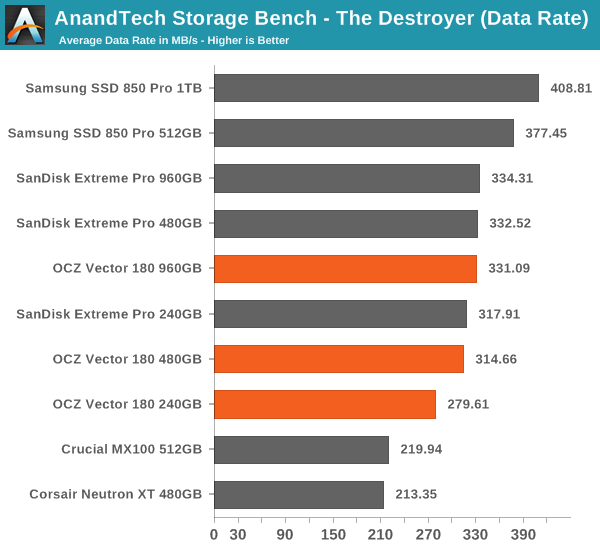
For a high-end drive, the Vector 180 has average data rate in our heaviest 'The Destroyer' trace. At 480GB and 960GB it's able to keep up with the Extreme Pro, but the 240GB model doesn't bear that well when compared to the competition.
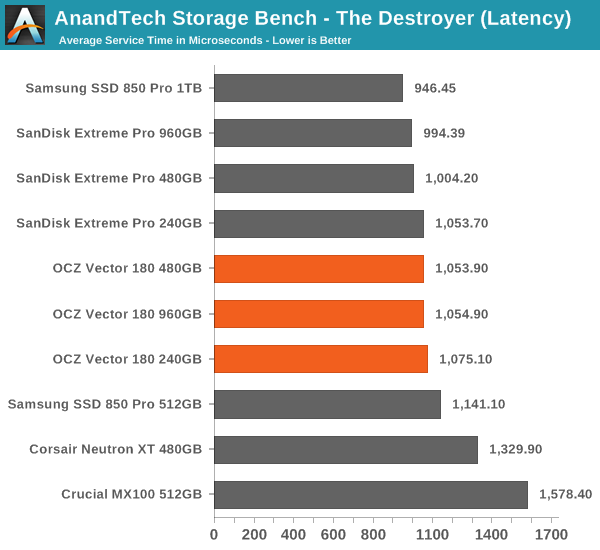
The same story continues when looking at average latency, although I have to say that the differences between drives are quite marginal. What's notable is how consistent the Vector 180 is regardless of the capacity.
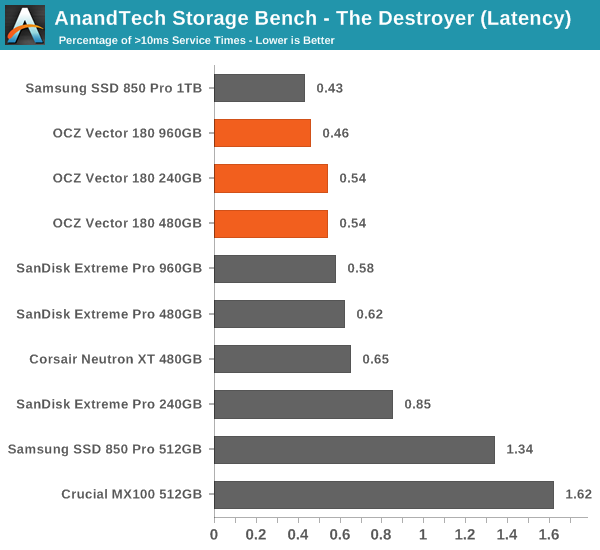
Positively, the Vector 180 has very few high latency IOs and actually leads the pack when looking at all capacities.
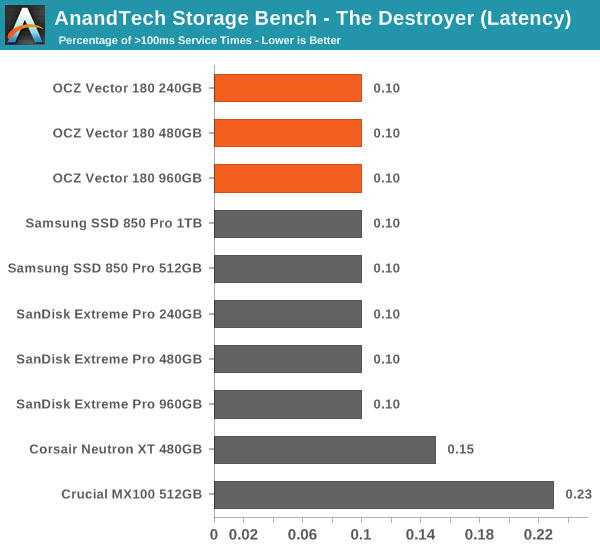
The Vector 180 also appears to be very power efficient under load and manages to beat every other SSD I've run through the test so far. Too bad there is no support for slumber power modes because the Barefoot 3 seems to excel otherwise when it comes to power.
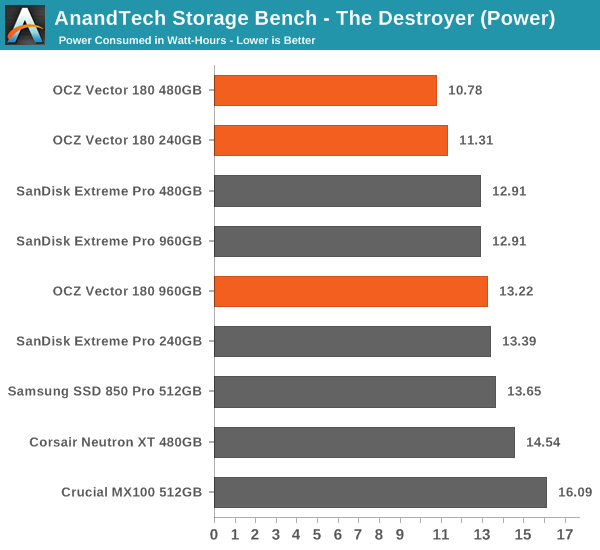










89 Comments
View All Comments
KAlmquist - Tuesday, March 24, 2015 - link
Vector 180 vx. MX 100:I think that the Crucial MX 100 will be a bit faster than the Vector 180 under typical usage, though the Vector 180 does outperform the MX 100 on some benchmarks. Both drives have partial power loss protection. The Vector 180 has a 5 year warranty vs. the 3 year warranty on the MX 100, but a lot of people will be looking to upgrade from SATA to PCIe SSD's before the 3 year warranty expires. In short, I don't see any reason to pay a premium price for the Vector 180.
MrCommunistGen - Tuesday, March 24, 2015 - link
If only HIPM+DIPM worked (yes I know its a hardware limitation of the platform) this looks like it'd be a great laptop SSD due to such low power consumption in the various workloads measured here.djsvetljo - Tuesday, March 24, 2015 - link
Two dead OCZ drives - there will never be a 3rd one. One of the drives was from the era of the bitcoins boom ( when they were easy to mine). Lost 150 coins there ( that's over $50 000). They stupid thing locked up due to power issues ( too many power cycles).STAY AWAY FROM OCZ
Antronman - Wednesday, March 25, 2015 - link
Well the thing is, the internals are drastically different right now.I've been in the market for a good SSD for a while. These drives seem to perform well. Sadly outperformed by the 850 Pro drives, but I do think that the enclosure is actually very aesthetically pleasing. If the cost could be driven down a lot, I'd be very interested in the 180.
mapesdhs - Wednesday, March 25, 2015 - link
You're right, they need to have a price advantage with the 180 to pull people in. Also,availability needs to be good - in the past it's been rather sketchy with the 150, which
means prices tend to creep up from a small number of suppliers.
Ian.
mapesdhs - Wednesday, March 25, 2015 - link
More than 30 OCZ drives, all working fine. Some had bad luck, others used Marvell portsand blame OCZ. It varies.
As for coins, well boohoo, not real money unless they're converted back to $.
Ian.
ocztosh - Monday, March 30, 2015 - link
Hi mapesdhs, thank you for your feedback and great to hear the drives are working well for you. We greatly appreciate both your business and support.FalcomPSX - Tuesday, March 24, 2015 - link
I've owned i think three OCZ drives in the past, they've all bricked on me within about a year. Never again will I purchase their shoddy products. While i was able to get warranty replacments each time, and the customer service is decent, the product itself is just not reliable in any way. I don't know if the new ones are improved at all, but i'm not risking MY data to find out.ocztosh - Wednesday, March 25, 2015 - link
Hello FalcomPSX, thank you for your comments and sorry to hear that you has a problem with previous drives. We are a new organization under Toshiba and have made significant changes to everything from processes to production. We understand how you feel and hope that one day we will have the opportunity to demonstrate the reliability of our current products. Thank you again for your feedbackNeatOman - Wednesday, March 25, 2015 - link
Battery backup should be built into the PSU for workstations and servers, google does this for their data centers.. why shouldn't servers and workstations. All you need is 1 minute for the average workstation to go into hibernation until power is back on IMO.